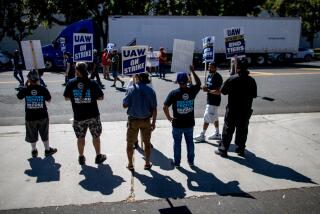Clinton Steps In, and Out on a Wing
- Share via
In taking decisive action to avert a potentially crippling American Airlines pilots strike, President Clinton decided that avoiding severe disruptions to the nation’s economy was worth raising the ire of his traditional allies in organized labor.
Clinton also risked sending the wrong signal to parties in similar labor disputes in the future: that they would not pursue serious bargaining because the White House would intervene anyway.
“That’s not a healthy way for labor negotiations to go,” said White House Deputy Counsel Bruce Lindsey, the administration advisor taking the lead on the American Airlines issue.
But for the president, the politics of the move appeared to balance out, although his advisors asserted that this was of no concern to him or them when they urged him to do what no president had done since 1966: sign a presidential order blocking an airline worker strike.
The AFL-CIO, American’s pilots union and other labor groups had made it clear they wanted the president to stay out of the dispute, under which the pilots were seeking increased wages and improved job security. They were perturbed when Clinton intervened.
The president decided that “it would be worse to have television showing stranded travelers and business interruptions than risk having labor unhappy with him,” said one labor union official who asked not to be named. “The president likes the idea that the economy is just humming along and he wants to keep it that way.”
However, labor will avoid any open break with the administration because of its Democratic leanings on such key issues as Social Security, Medicare, the budget and taxes, all of which will be in play in Congress this session.
American Airlines wanted the president to pressure the pilots to accept binding arbitration. Senators, governors and mayors from affected cities were lobbying the president strongly to intervene.
Denver, Chicago and Dallas-Fort Worth, where American has a large presence, would suffer serious economic blows and disruption of business travel under a strike. An estimated 43,000 travelers could not be accommodated on other airlines, and the airline estimated it would lose up to $50 million per day.
The president’s advisors forestalled their recommendation until the very end.
It was only hours before the Friday midnight strike deadline that advisor Lindsey stopped wobbling and decided to recommend presidential action.
“I did not come to that until Friday,” Lindsey said. “Before that, I went back and forth. I used to practice labor law, and I didn’t want to change the nature of bargaining in the airlines industry.”
He knew that, because presidents routinely use emergency boards to help settle labor disputes in the railway industry, the parties involved in rail labor disputes rarely negotiate seriously until the president appoints such a board. He did not want that mind set to develop in this dispute.
About 7:30 p.m. PST Friday, Lindsey spent 15 minutes with the president, explaining that no agreement was in sight.
One option the president was considering was to let the strike go on for a few hours to pressure the parties to come to a resolution.
But at midnight, Lindsey got a report that the talks had broken down. Clinton stepped in.
Lindsey acknowledged that “60 days from now, we may be back to where we were a few days ago.”
But most airline industry analysts argued that intervention was the only choice.
“Obviously, it was politically motivated,” said Rich Barlow, director of GRA Aviation Specialists Inc. of Herndon, Va. “There were clear expectations that he was going to step in. It was inevitable because of all of the focus the public has on the airline industry.”
Times staff writer Robert A. Rosenblatt contributed to this story.
More to Read
Inside the business of entertainment
The Wide Shot brings you news, analysis and insights on everything from streaming wars to production — and what it all means for the future.
You may occasionally receive promotional content from the Los Angeles Times.










